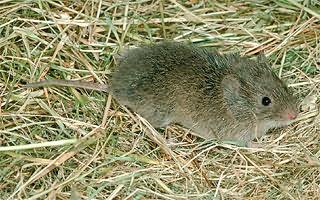The vole, not the mole, made the hole
Originally appeared in Bay Area News Group publications on August 15th and 24th, 2008

California Vole (photo from voles.com)
It has been over a month since I saw it – a small, round, short-tailed, small-eared, furry creature. It looked like a mouse, but wasn’t.
I was pruning the jasmine on the back fence when this cute-nik, looking neither left nor right, scurried past me. In the second or two I had to ponder this development, I just smiled, rather than attempting to end its short life. That is a decision I do not regret, although a number of holes in our garden occasionally cause me to reconsider.
What had I seen and why does my wife encounter it, always in early evening, as it ambles either to or from work (she can’t tell which)? It wasn’t a gopher because it did not have the distinctive, large, curved front claws. Nor were there any crescent or horseshoe shaped mounds, which would have resulted from their underground excavations.
Being the “Squirrel Dundee” of Oakland, I concluded the rascal was either a mole or a vole. But, which one was it, and what is the difference? As I have done so often in the past, I followed my adventurous spirit and searched the wild world of the Internet. It was here I found the answer.
Assisted by my viewing experiences of CSI in its various incarnations, I was able to eliminate the mole as a suspect. After all, the critter we saw did not have the longer snout and nails of a mole, nor does our backyard have subterranean tunnels ending in numerous mounds resembling tiny volcanoes. There were no raised ridges indicating the shallower mole tunnel.
That left only the vole, also called a “field” or “meadow mouse.” Our garden resident is most likely a species called the “California” vole, because, as I forgot to mention, the one I saw was wearing sunglasses.
Narrowing this down to the vole was not necessarily good news because they are more destructive than moles. They make runways, connecting burrow openings, near the surface of the ground. This can be especially damaging to a lawn.
With large top teeth, voles munch on vegetation such as grass, bulbs and roots. They also chew on young trees and shrubs, sometimes removing bark, which allows for disease. As opposed to moles, which produce two to five offspring a year, voles are rodents that multiply like rabbits.
Voles typically live between two and sixteen months. They make up for their short lives by reproducing early and often. Females can become pregnant when only 13 days old. After a gestation of 16 to 24 days, they deliver three to eight babies. Thus, the first birth can occur after a female is just a month or so of age. No wonder the children have no time to learn manners. A female can have as many as 12 litters a year; however, three to five is typical. So, how many voles are living in or near our backyard? The answer could be scary.
To make things even more complicated, there is another rodent called a mole-vole, found in Russia, Kazakhstan, China, Mongolia and some of the surrounding countries. I will write about that when I find one in our garden.